University Nursing Case Study: Clinical Scenario and Analysis
VerifiedAdded on 2022/10/18
|10
|2564
|150
Case Study
AI Summary
This case study presents a critical clinical scenario in a nursing context, focusing on a patient admitted with community-acquired pneumonia who subsequently developed sepsis and respiratory failure. The core issue revolves around a delay in transferring the patient to the ICU due to a lack ...
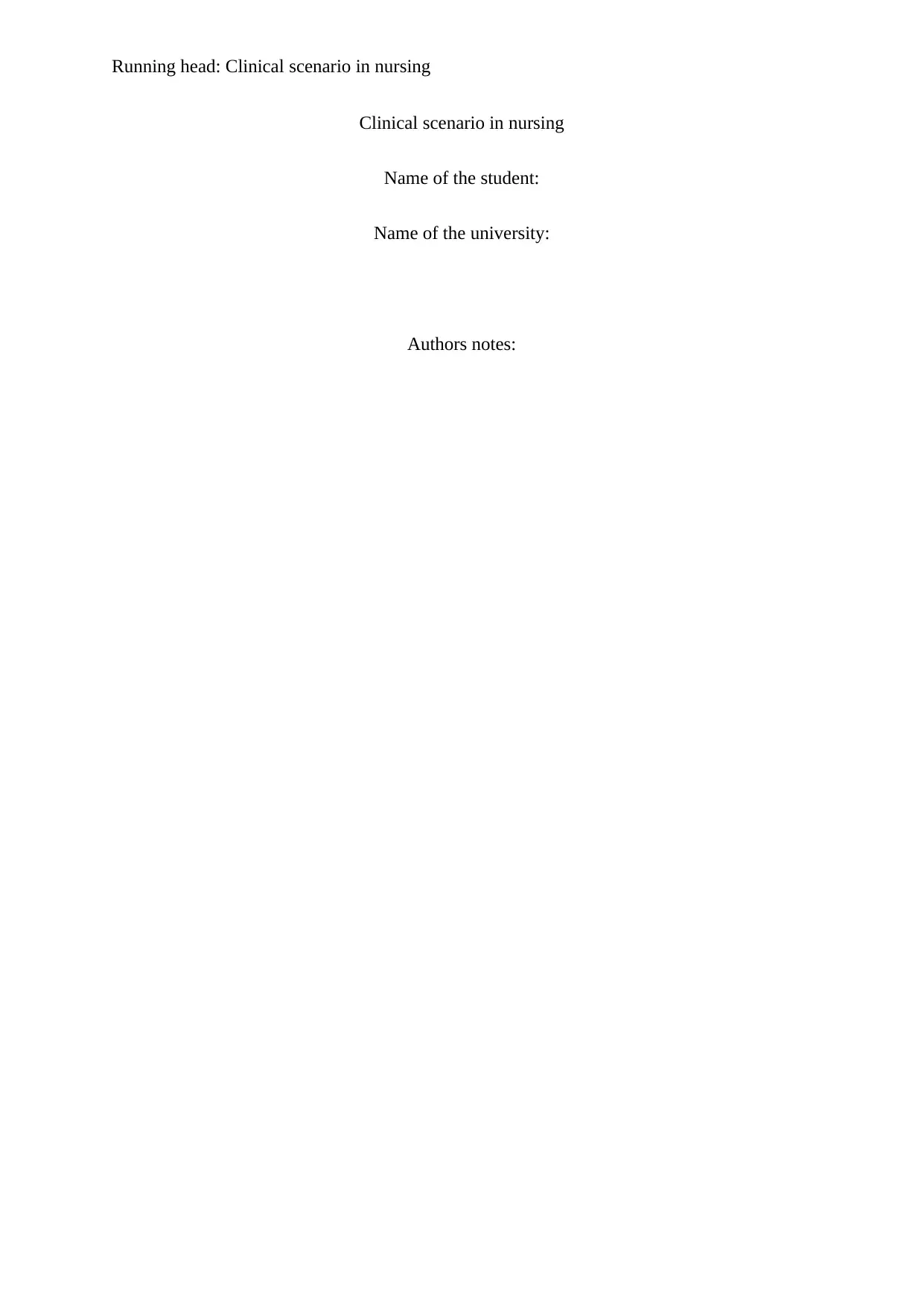
Running head: Clinical scenario in nursing
Clinical scenario in nursing
Name of the student:
Name of the university:
Authors notes:
Clinical scenario in nursing
Name of the student:
Name of the university:
Authors notes:
Paraphrase This Document
Need a fresh take? Get an instant paraphrase of this document with our AI Paraphraser
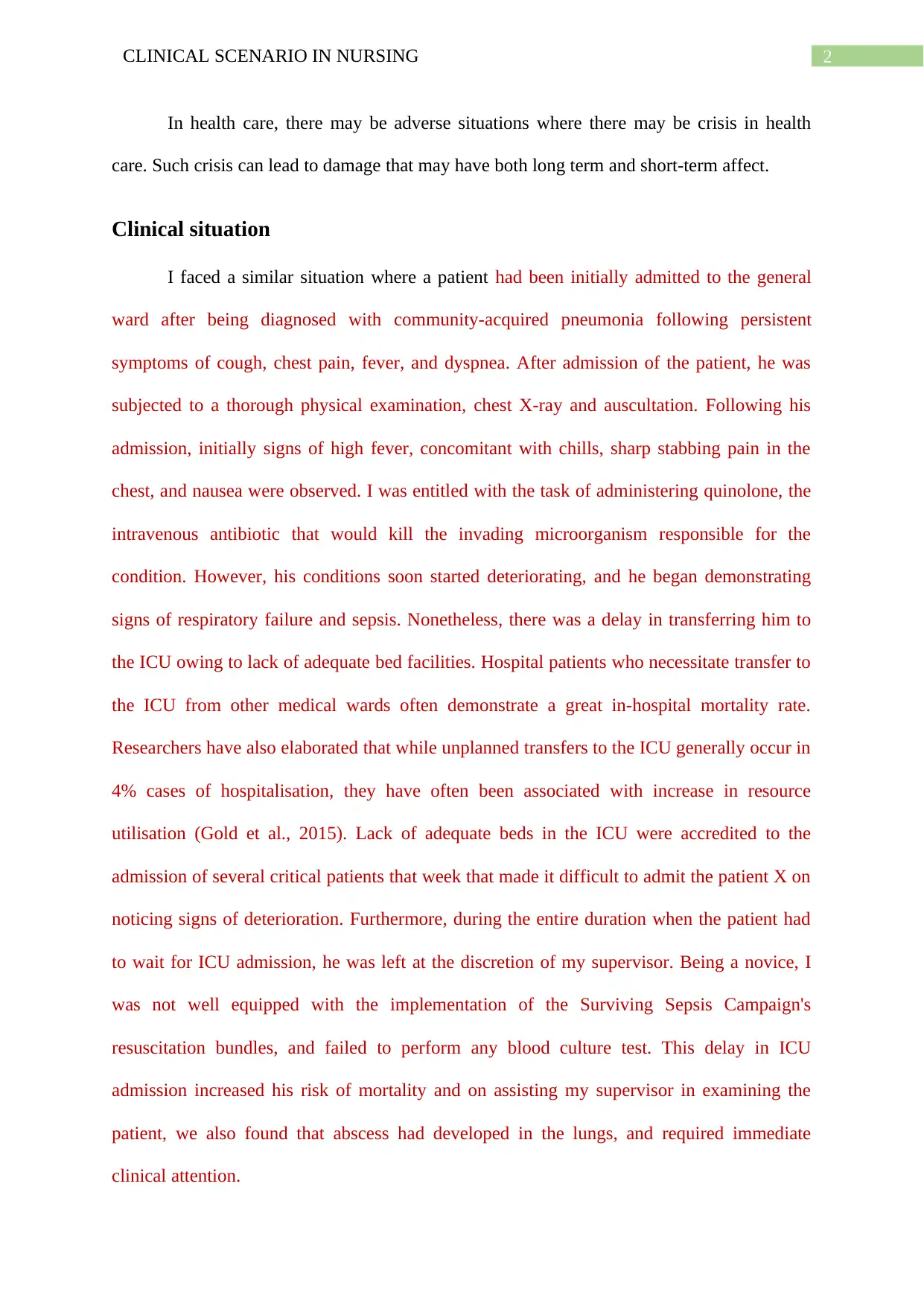
2CLINICAL SCENARIO IN NURSING
In health care, there may be adverse situations where there may be crisis in health
care. Such crisis can lead to damage that may have both long term and short-term affect.
Clinical situation
I faced a similar situation where a patient had been initially admitted to the general
ward after being diagnosed with community-acquired pneumonia following persistent
symptoms of cough, chest pain, fever, and dyspnea. After admission of the patient, he was
subjected to a thorough physical examination, chest X-ray and auscultation. Following his
admission, initially signs of high fever, concomitant with chills, sharp stabbing pain in the
chest, and nausea were observed. I was entitled with the task of administering quinolone, the
intravenous antibiotic that would kill the invading microorganism responsible for the
condition. However, his conditions soon started deteriorating, and he began demonstrating
signs of respiratory failure and sepsis. Nonetheless, there was a delay in transferring him to
the ICU owing to lack of adequate bed facilities. Hospital patients who necessitate transfer to
the ICU from other medical wards often demonstrate a great in-hospital mortality rate.
Researchers have also elaborated that while unplanned transfers to the ICU generally occur in
4% cases of hospitalisation, they have often been associated with increase in resource
utilisation (Gold et al., 2015). Lack of adequate beds in the ICU were accredited to the
admission of several critical patients that week that made it difficult to admit the patient X on
noticing signs of deterioration. Furthermore, during the entire duration when the patient had
to wait for ICU admission, he was left at the discretion of my supervisor. Being a novice, I
was not well equipped with the implementation of the Surviving Sepsis Campaign's
resuscitation bundles, and failed to perform any blood culture test. This delay in ICU
admission increased his risk of mortality and on assisting my supervisor in examining the
patient, we also found that abscess had developed in the lungs, and required immediate
clinical attention.
In health care, there may be adverse situations where there may be crisis in health
care. Such crisis can lead to damage that may have both long term and short-term affect.
Clinical situation
I faced a similar situation where a patient had been initially admitted to the general
ward after being diagnosed with community-acquired pneumonia following persistent
symptoms of cough, chest pain, fever, and dyspnea. After admission of the patient, he was
subjected to a thorough physical examination, chest X-ray and auscultation. Following his
admission, initially signs of high fever, concomitant with chills, sharp stabbing pain in the
chest, and nausea were observed. I was entitled with the task of administering quinolone, the
intravenous antibiotic that would kill the invading microorganism responsible for the
condition. However, his conditions soon started deteriorating, and he began demonstrating
signs of respiratory failure and sepsis. Nonetheless, there was a delay in transferring him to
the ICU owing to lack of adequate bed facilities. Hospital patients who necessitate transfer to
the ICU from other medical wards often demonstrate a great in-hospital mortality rate.
Researchers have also elaborated that while unplanned transfers to the ICU generally occur in
4% cases of hospitalisation, they have often been associated with increase in resource
utilisation (Gold et al., 2015). Lack of adequate beds in the ICU were accredited to the
admission of several critical patients that week that made it difficult to admit the patient X on
noticing signs of deterioration. Furthermore, during the entire duration when the patient had
to wait for ICU admission, he was left at the discretion of my supervisor. Being a novice, I
was not well equipped with the implementation of the Surviving Sepsis Campaign's
resuscitation bundles, and failed to perform any blood culture test. This delay in ICU
admission increased his risk of mortality and on assisting my supervisor in examining the
patient, we also found that abscess had developed in the lungs, and required immediate
clinical attention.

3CLINICAL SCENARIO IN NURSING
Short term and long term impact of this clinical situation on the staff
The staff members or the hospital staffs are mostly affected by such incidents. There
are many long-term effects like work related stress, burnout, and loss of interest in job and it
is has often been found that failure to effectively administer care services to patient takes an
emotional toll on the staff, involved in delivering critical care. The staff members may not be
in direct fault but due to negligence, there may be serious consequences. (Calder et al, 2016).
In such a situation, healthcare professionals along with the management members of the
hospital are held accountable for their actions, based on the health consequences of the
patient. These kinds of incidents harm the image of the staff members and the family
members of the patients develop apathy and resentment towards the former. Owing to the
preventable and avoidable nature of such incidents, healthcare professionals are also
subjected to mental trauma and often question their role as a healthcare staff. The staff also
becomes apprehensive of looking after any other patient who reports similar signs and
symptoms, and also takes all necessary efforts to ensure that all patients are treated with
utmost priority (Quillivan et al., 2016). They have to endure extreme mental and emotional
trauma while providing a justification for their actions as wel, owing to the fact that when left
untreated, sepsis and respiratory failure might also lead to patient death.
As an advanced practice nurse or nurse practitioner description of the role and
responsibilities of unit managers and senior clinicians who may be involved in
responding
to individual staff involved in an adverse event
These cases are difficult to handle, as there is no direct fault by any one particular
person. In the incident stated above it can be suggested that there was failure on the part of
the hospital authorities who failed to ensure the presence of adequate ICU beds. Thus, it was
Short term and long term impact of this clinical situation on the staff
The staff members or the hospital staffs are mostly affected by such incidents. There
are many long-term effects like work related stress, burnout, and loss of interest in job and it
is has often been found that failure to effectively administer care services to patient takes an
emotional toll on the staff, involved in delivering critical care. The staff members may not be
in direct fault but due to negligence, there may be serious consequences. (Calder et al, 2016).
In such a situation, healthcare professionals along with the management members of the
hospital are held accountable for their actions, based on the health consequences of the
patient. These kinds of incidents harm the image of the staff members and the family
members of the patients develop apathy and resentment towards the former. Owing to the
preventable and avoidable nature of such incidents, healthcare professionals are also
subjected to mental trauma and often question their role as a healthcare staff. The staff also
becomes apprehensive of looking after any other patient who reports similar signs and
symptoms, and also takes all necessary efforts to ensure that all patients are treated with
utmost priority (Quillivan et al., 2016). They have to endure extreme mental and emotional
trauma while providing a justification for their actions as wel, owing to the fact that when left
untreated, sepsis and respiratory failure might also lead to patient death.
As an advanced practice nurse or nurse practitioner description of the role and
responsibilities of unit managers and senior clinicians who may be involved in
responding
to individual staff involved in an adverse event
These cases are difficult to handle, as there is no direct fault by any one particular
person. In the incident stated above it can be suggested that there was failure on the part of
the hospital authorities who failed to ensure the presence of adequate ICU beds. Thus, it was
⊘ This is a preview!⊘
Do you want full access?
Subscribe today to unlock all pages.

Trusted by 1+ million students worldwide
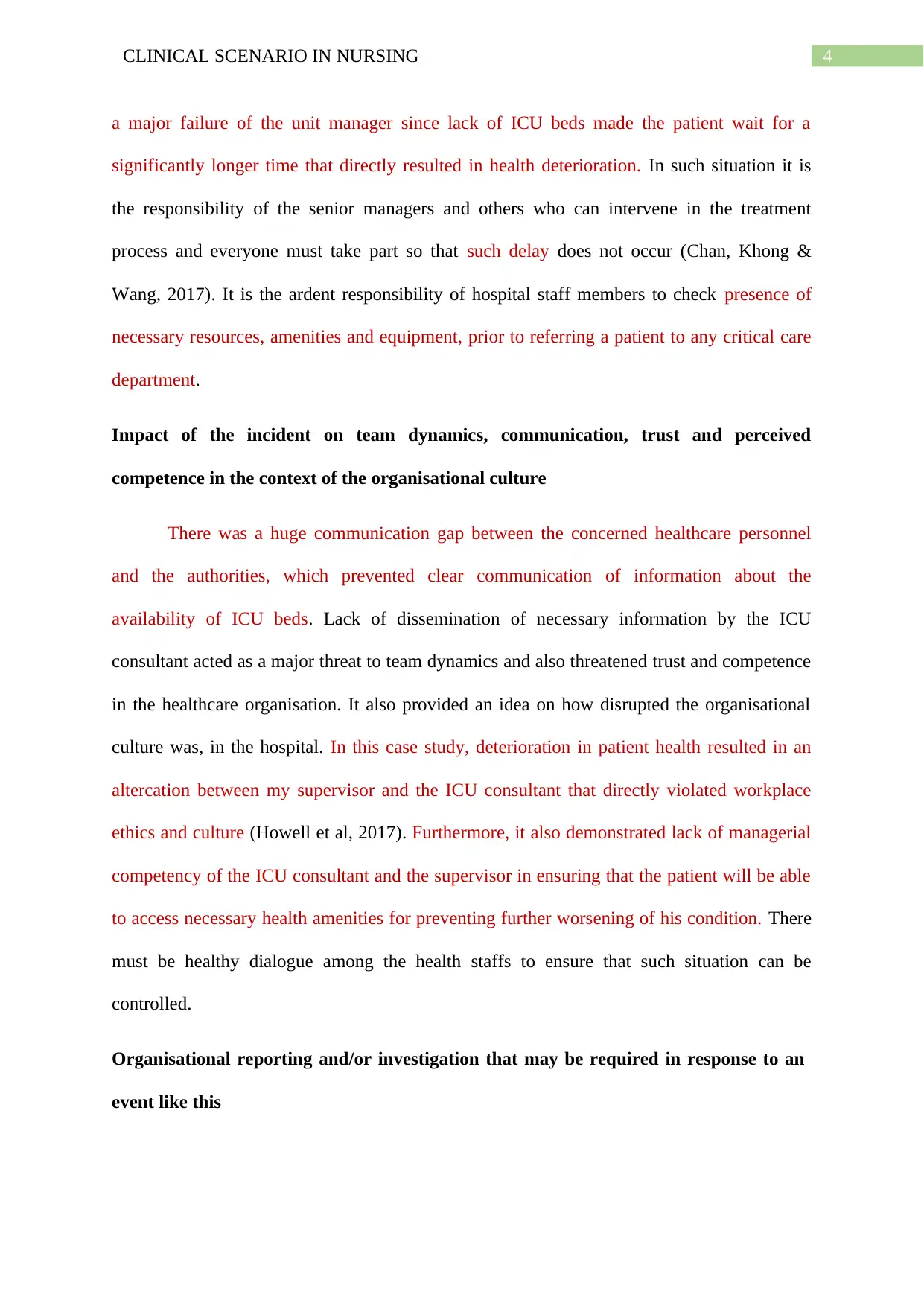
4CLINICAL SCENARIO IN NURSING
a major failure of the unit manager since lack of ICU beds made the patient wait for a
significantly longer time that directly resulted in health deterioration. In such situation it is
the responsibility of the senior managers and others who can intervene in the treatment
process and everyone must take part so that such delay does not occur (Chan, Khong &
Wang, 2017). It is the ardent responsibility of hospital staff members to check presence of
necessary resources, amenities and equipment, prior to referring a patient to any critical care
department.
Impact of the incident on team dynamics, communication, trust and perceived
competence in the context of the organisational culture
There was a huge communication gap between the concerned healthcare personnel
and the authorities, which prevented clear communication of information about the
availability of ICU beds. Lack of dissemination of necessary information by the ICU
consultant acted as a major threat to team dynamics and also threatened trust and competence
in the healthcare organisation. It also provided an idea on how disrupted the organisational
culture was, in the hospital. In this case study, deterioration in patient health resulted in an
altercation between my supervisor and the ICU consultant that directly violated workplace
ethics and culture (Howell et al, 2017). Furthermore, it also demonstrated lack of managerial
competency of the ICU consultant and the supervisor in ensuring that the patient will be able
to access necessary health amenities for preventing further worsening of his condition. There
must be healthy dialogue among the health staffs to ensure that such situation can be
controlled.
Organisational reporting and/or investigation that may be required in response to an
event like this
a major failure of the unit manager since lack of ICU beds made the patient wait for a
significantly longer time that directly resulted in health deterioration. In such situation it is
the responsibility of the senior managers and others who can intervene in the treatment
process and everyone must take part so that such delay does not occur (Chan, Khong &
Wang, 2017). It is the ardent responsibility of hospital staff members to check presence of
necessary resources, amenities and equipment, prior to referring a patient to any critical care
department.
Impact of the incident on team dynamics, communication, trust and perceived
competence in the context of the organisational culture
There was a huge communication gap between the concerned healthcare personnel
and the authorities, which prevented clear communication of information about the
availability of ICU beds. Lack of dissemination of necessary information by the ICU
consultant acted as a major threat to team dynamics and also threatened trust and competence
in the healthcare organisation. It also provided an idea on how disrupted the organisational
culture was, in the hospital. In this case study, deterioration in patient health resulted in an
altercation between my supervisor and the ICU consultant that directly violated workplace
ethics and culture (Howell et al, 2017). Furthermore, it also demonstrated lack of managerial
competency of the ICU consultant and the supervisor in ensuring that the patient will be able
to access necessary health amenities for preventing further worsening of his condition. There
must be healthy dialogue among the health staffs to ensure that such situation can be
controlled.
Organisational reporting and/or investigation that may be required in response to an
event like this
Paraphrase This Document
Need a fresh take? Get an instant paraphrase of this document with our AI Paraphraser

5CLINICAL SCENARIO IN NURSING
Patient safety reporting systems are generally ubiquitous across different hospitals and
have been identified as a mainstay of efforts for the detection of patient safety quality and
events problems (Cooper et al., 2018). Hence, incident reporting must be reliant on providing
detailed information about the underlying factors that resulted the delay of ICU admission of
the patient. The investigation in such event is important to understand and evaluate to see
how the situation prevailed and what step could have prevented such incidents. Reporting
must be based on identifying the number of ICU beds that are present in the hospital, and
those that were occupied by patients at that time (Macrae, 2016). A detailed record of patients
who were admitted to ICU and the health problems they were suffering from also needs to be
maintained. This will determine the existing % fill rate of their ICU beds.
Family members of patients and concerned healthcare personnel also need to be
interrogated to identify the events that eventually resulted in treatment delay, thus providing a
clear explanation behind the incident. The patient must be allowed to speak on how he was
treated (Stavropoulou, Doherty & Tosey, 2015). The ICU consultant who is largely at fault in
such circumstances must also be questioned, and provided a show-cause notice to provide a
justification for failure of the hospital in providing high quality service to the patient (Bates et
al., 2016). Such errors generally result due to poor organisational management and can be
avoided by proper communication between the stakeholders.
Need of clinical evaluation in such incidents following an adverse event
It is imperative to conduct a clinical evaluation for such incidents owing to the fact
that results from the evaluation can be used for the identification of safety concerns that are
associated to patient health outcome. In addition, it would also facilitate assessing compliance
of the healthcare professionals and authorities to patient care and reporting regulations. In
other words, there is a need of clinical evaluation so as to ascertain the main reason behind
Patient safety reporting systems are generally ubiquitous across different hospitals and
have been identified as a mainstay of efforts for the detection of patient safety quality and
events problems (Cooper et al., 2018). Hence, incident reporting must be reliant on providing
detailed information about the underlying factors that resulted the delay of ICU admission of
the patient. The investigation in such event is important to understand and evaluate to see
how the situation prevailed and what step could have prevented such incidents. Reporting
must be based on identifying the number of ICU beds that are present in the hospital, and
those that were occupied by patients at that time (Macrae, 2016). A detailed record of patients
who were admitted to ICU and the health problems they were suffering from also needs to be
maintained. This will determine the existing % fill rate of their ICU beds.
Family members of patients and concerned healthcare personnel also need to be
interrogated to identify the events that eventually resulted in treatment delay, thus providing a
clear explanation behind the incident. The patient must be allowed to speak on how he was
treated (Stavropoulou, Doherty & Tosey, 2015). The ICU consultant who is largely at fault in
such circumstances must also be questioned, and provided a show-cause notice to provide a
justification for failure of the hospital in providing high quality service to the patient (Bates et
al., 2016). Such errors generally result due to poor organisational management and can be
avoided by proper communication between the stakeholders.
Need of clinical evaluation in such incidents following an adverse event
It is imperative to conduct a clinical evaluation for such incidents owing to the fact
that results from the evaluation can be used for the identification of safety concerns that are
associated to patient health outcome. In addition, it would also facilitate assessing compliance
of the healthcare professionals and authorities to patient care and reporting regulations. In
other words, there is a need of clinical evaluation so as to ascertain the main reason behind
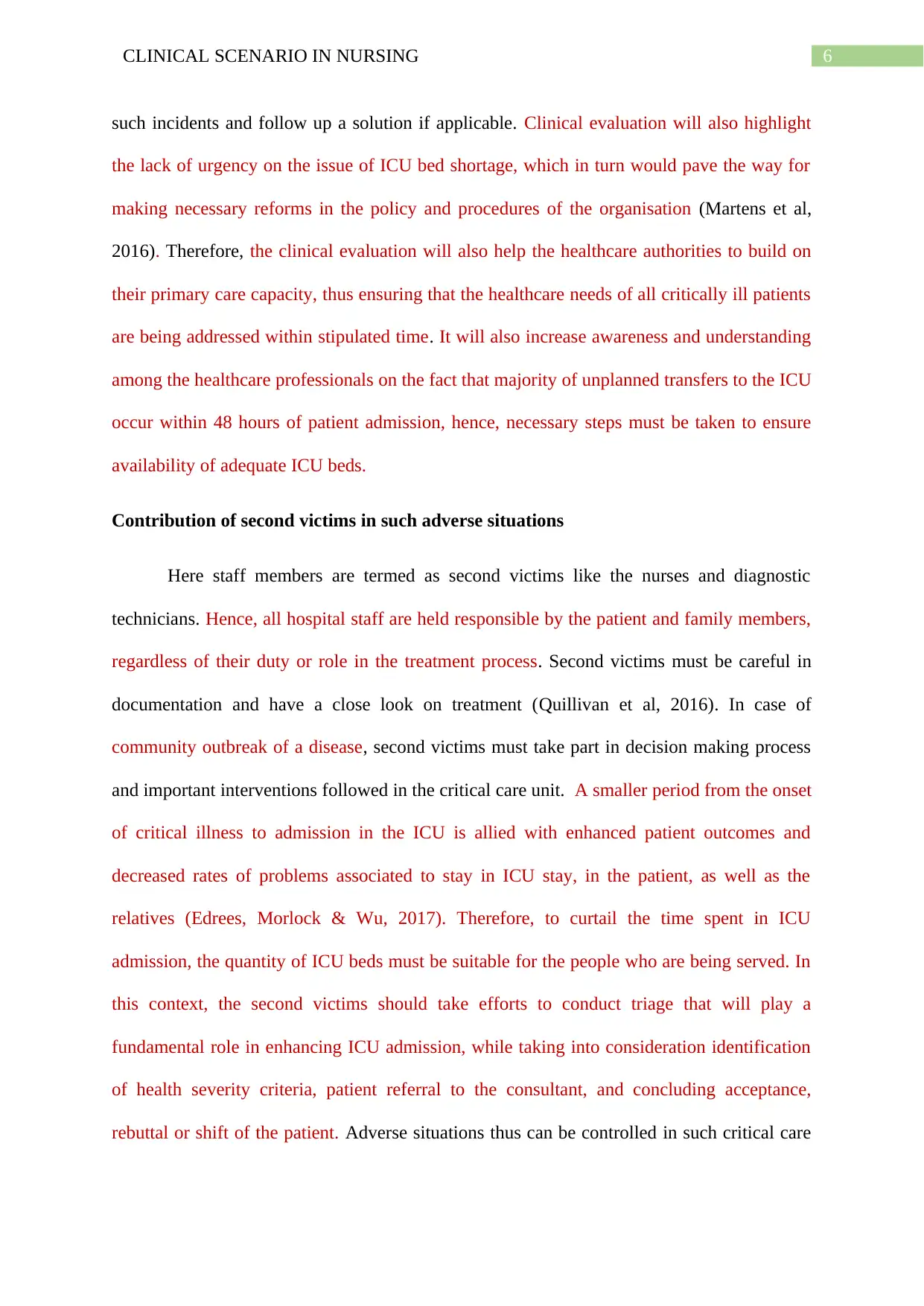
6CLINICAL SCENARIO IN NURSING
such incidents and follow up a solution if applicable. Clinical evaluation will also highlight
the lack of urgency on the issue of ICU bed shortage, which in turn would pave the way for
making necessary reforms in the policy and procedures of the organisation (Martens et al,
2016). Therefore, the clinical evaluation will also help the healthcare authorities to build on
their primary care capacity, thus ensuring that the healthcare needs of all critically ill patients
are being addressed within stipulated time. It will also increase awareness and understanding
among the healthcare professionals on the fact that majority of unplanned transfers to the ICU
occur within 48 hours of patient admission, hence, necessary steps must be taken to ensure
availability of adequate ICU beds.
Contribution of second victims in such adverse situations
Here staff members are termed as second victims like the nurses and diagnostic
technicians. Hence, all hospital staff are held responsible by the patient and family members,
regardless of their duty or role in the treatment process. Second victims must be careful in
documentation and have a close look on treatment (Quillivan et al, 2016). In case of
community outbreak of a disease, second victims must take part in decision making process
and important interventions followed in the critical care unit. A smaller period from the onset
of critical illness to admission in the ICU is allied with enhanced patient outcomes and
decreased rates of problems associated to stay in ICU stay, in the patient, as well as the
relatives (Edrees, Morlock & Wu, 2017). Therefore, to curtail the time spent in ICU
admission, the quantity of ICU beds must be suitable for the people who are being served. In
this context, the second victims should take efforts to conduct triage that will play a
fundamental role in enhancing ICU admission, while taking into consideration identification
of health severity criteria, patient referral to the consultant, and concluding acceptance,
rebuttal or shift of the patient. Adverse situations thus can be controlled in such critical care
such incidents and follow up a solution if applicable. Clinical evaluation will also highlight
the lack of urgency on the issue of ICU bed shortage, which in turn would pave the way for
making necessary reforms in the policy and procedures of the organisation (Martens et al,
2016). Therefore, the clinical evaluation will also help the healthcare authorities to build on
their primary care capacity, thus ensuring that the healthcare needs of all critically ill patients
are being addressed within stipulated time. It will also increase awareness and understanding
among the healthcare professionals on the fact that majority of unplanned transfers to the ICU
occur within 48 hours of patient admission, hence, necessary steps must be taken to ensure
availability of adequate ICU beds.
Contribution of second victims in such adverse situations
Here staff members are termed as second victims like the nurses and diagnostic
technicians. Hence, all hospital staff are held responsible by the patient and family members,
regardless of their duty or role in the treatment process. Second victims must be careful in
documentation and have a close look on treatment (Quillivan et al, 2016). In case of
community outbreak of a disease, second victims must take part in decision making process
and important interventions followed in the critical care unit. A smaller period from the onset
of critical illness to admission in the ICU is allied with enhanced patient outcomes and
decreased rates of problems associated to stay in ICU stay, in the patient, as well as the
relatives (Edrees, Morlock & Wu, 2017). Therefore, to curtail the time spent in ICU
admission, the quantity of ICU beds must be suitable for the people who are being served. In
this context, the second victims should take efforts to conduct triage that will play a
fundamental role in enhancing ICU admission, while taking into consideration identification
of health severity criteria, patient referral to the consultant, and concluding acceptance,
rebuttal or shift of the patient. Adverse situations thus can be controlled in such critical care
⊘ This is a preview!⊘
Do you want full access?
Subscribe today to unlock all pages.

Trusted by 1+ million students worldwide
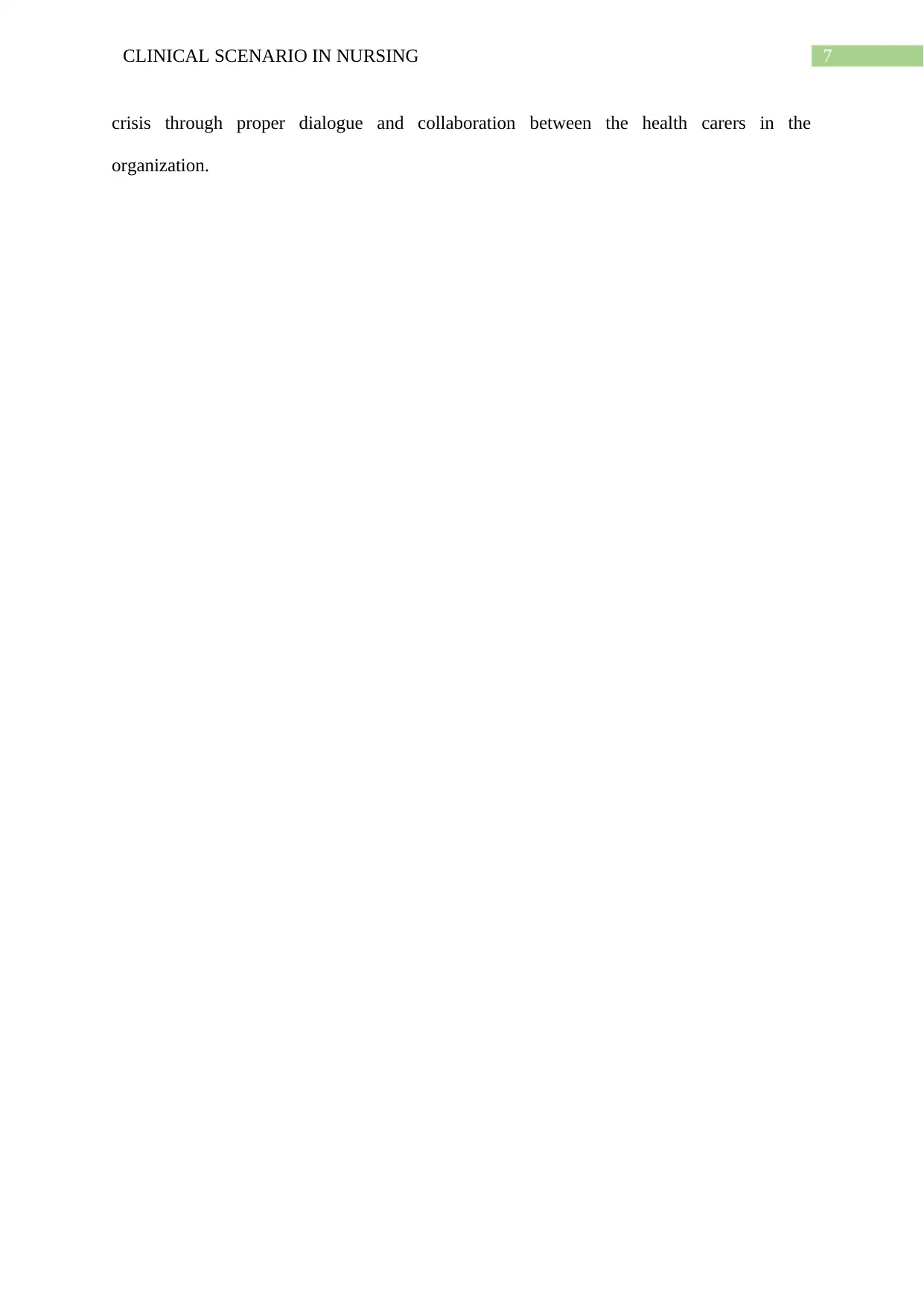
7CLINICAL SCENARIO IN NURSING
crisis through proper dialogue and collaboration between the health carers in the
organization.
crisis through proper dialogue and collaboration between the health carers in the
organization.
Paraphrase This Document
Need a fresh take? Get an instant paraphrase of this document with our AI Paraphraser
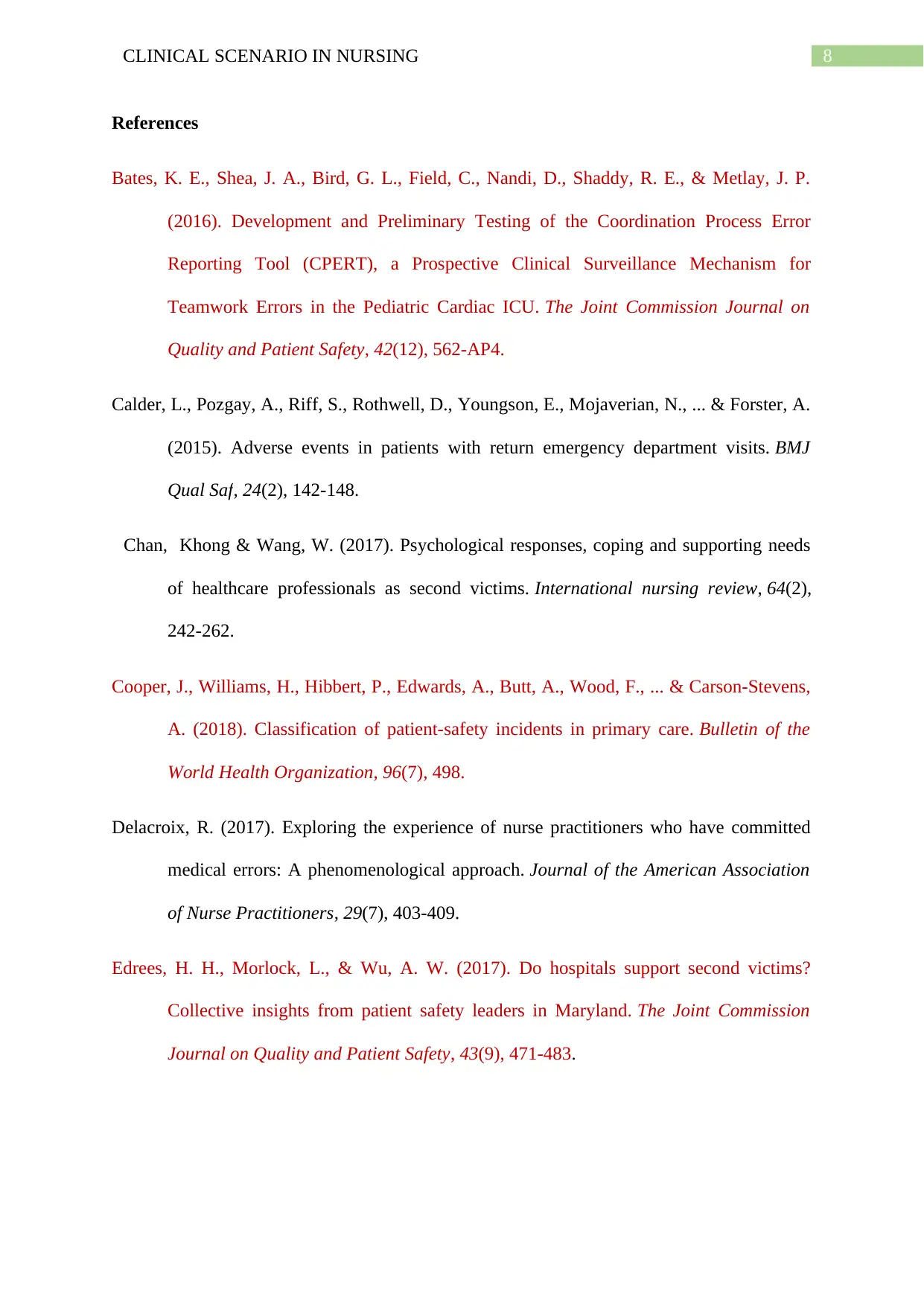
8CLINICAL SCENARIO IN NURSING
References
Bates, K. E., Shea, J. A., Bird, G. L., Field, C., Nandi, D., Shaddy, R. E., & Metlay, J. P.
(2016). Development and Preliminary Testing of the Coordination Process Error
Reporting Tool (CPERT), a Prospective Clinical Surveillance Mechanism for
Teamwork Errors in the Pediatric Cardiac ICU. The Joint Commission Journal on
Quality and Patient Safety, 42(12), 562-AP4.
Calder, L., Pozgay, A., Riff, S., Rothwell, D., Youngson, E., Mojaverian, N., ... & Forster, A.
(2015). Adverse events in patients with return emergency department visits. BMJ
Qual Saf, 24(2), 142-148.
Chan, Khong & Wang, W. (2017). Psychological responses, coping and supporting needs
of healthcare professionals as second victims. International nursing review, 64(2),
242-262.
Cooper, J., Williams, H., Hibbert, P., Edwards, A., Butt, A., Wood, F., ... & Carson-Stevens,
A. (2018). Classification of patient-safety incidents in primary care. Bulletin of the
World Health Organization, 96(7), 498.
Delacroix, R. (2017). Exploring the experience of nurse practitioners who have committed
medical errors: A phenomenological approach. Journal of the American Association
of Nurse Practitioners, 29(7), 403-409.
Edrees, H. H., Morlock, L., & Wu, A. W. (2017). Do hospitals support second victims?
Collective insights from patient safety leaders in Maryland. The Joint Commission
Journal on Quality and Patient Safety, 43(9), 471-483.
References
Bates, K. E., Shea, J. A., Bird, G. L., Field, C., Nandi, D., Shaddy, R. E., & Metlay, J. P.
(2016). Development and Preliminary Testing of the Coordination Process Error
Reporting Tool (CPERT), a Prospective Clinical Surveillance Mechanism for
Teamwork Errors in the Pediatric Cardiac ICU. The Joint Commission Journal on
Quality and Patient Safety, 42(12), 562-AP4.
Calder, L., Pozgay, A., Riff, S., Rothwell, D., Youngson, E., Mojaverian, N., ... & Forster, A.
(2015). Adverse events in patients with return emergency department visits. BMJ
Qual Saf, 24(2), 142-148.
Chan, Khong & Wang, W. (2017). Psychological responses, coping and supporting needs
of healthcare professionals as second victims. International nursing review, 64(2),
242-262.
Cooper, J., Williams, H., Hibbert, P., Edwards, A., Butt, A., Wood, F., ... & Carson-Stevens,
A. (2018). Classification of patient-safety incidents in primary care. Bulletin of the
World Health Organization, 96(7), 498.
Delacroix, R. (2017). Exploring the experience of nurse practitioners who have committed
medical errors: A phenomenological approach. Journal of the American Association
of Nurse Practitioners, 29(7), 403-409.
Edrees, H. H., Morlock, L., & Wu, A. W. (2017). Do hospitals support second victims?
Collective insights from patient safety leaders in Maryland. The Joint Commission
Journal on Quality and Patient Safety, 43(9), 471-483.
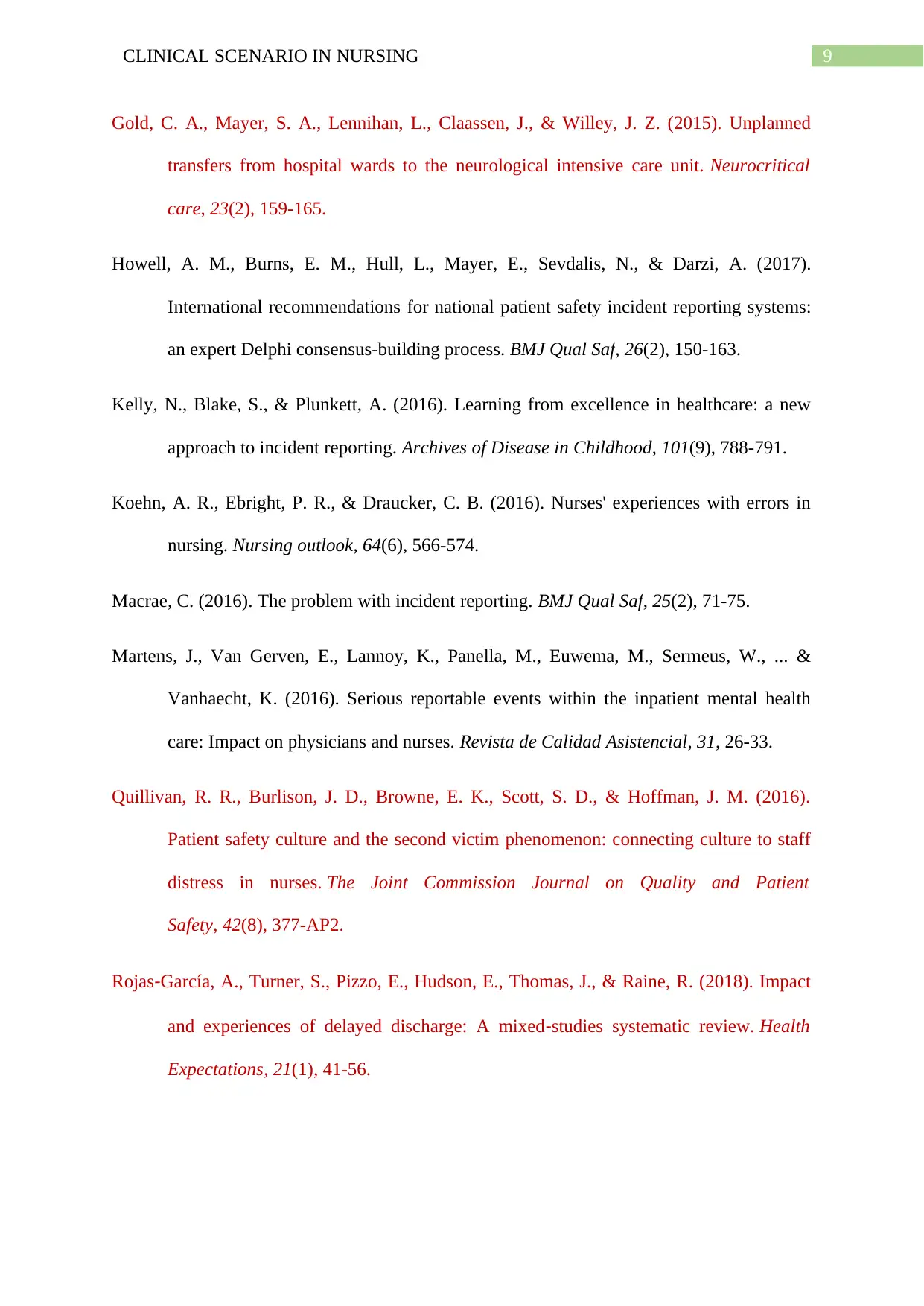
9CLINICAL SCENARIO IN NURSING
Gold, C. A., Mayer, S. A., Lennihan, L., Claassen, J., & Willey, J. Z. (2015). Unplanned
transfers from hospital wards to the neurological intensive care unit. Neurocritical
care, 23(2), 159-165.
Howell, A. M., Burns, E. M., Hull, L., Mayer, E., Sevdalis, N., & Darzi, A. (2017).
International recommendations for national patient safety incident reporting systems:
an expert Delphi consensus-building process. BMJ Qual Saf, 26(2), 150-163.
Kelly, N., Blake, S., & Plunkett, A. (2016). Learning from excellence in healthcare: a new
approach to incident reporting. Archives of Disease in Childhood, 101(9), 788-791.
Koehn, A. R., Ebright, P. R., & Draucker, C. B. (2016). Nurses' experiences with errors in
nursing. Nursing outlook, 64(6), 566-574.
Macrae, C. (2016). The problem with incident reporting. BMJ Qual Saf, 25(2), 71-75.
Martens, J., Van Gerven, E., Lannoy, K., Panella, M., Euwema, M., Sermeus, W., ... &
Vanhaecht, K. (2016). Serious reportable events within the inpatient mental health
care: Impact on physicians and nurses. Revista de Calidad Asistencial, 31, 26-33.
Quillivan, R. R., Burlison, J. D., Browne, E. K., Scott, S. D., & Hoffman, J. M. (2016).
Patient safety culture and the second victim phenomenon: connecting culture to staff
distress in nurses. The Joint Commission Journal on Quality and Patient
Safety, 42(8), 377-AP2.
Rojas‐García, A., Turner, S., Pizzo, E., Hudson, E., Thomas, J., & Raine, R. (2018). Impact
and experiences of delayed discharge: A mixed‐studies systematic review. Health
Expectations, 21(1), 41-56.
Gold, C. A., Mayer, S. A., Lennihan, L., Claassen, J., & Willey, J. Z. (2015). Unplanned
transfers from hospital wards to the neurological intensive care unit. Neurocritical
care, 23(2), 159-165.
Howell, A. M., Burns, E. M., Hull, L., Mayer, E., Sevdalis, N., & Darzi, A. (2017).
International recommendations for national patient safety incident reporting systems:
an expert Delphi consensus-building process. BMJ Qual Saf, 26(2), 150-163.
Kelly, N., Blake, S., & Plunkett, A. (2016). Learning from excellence in healthcare: a new
approach to incident reporting. Archives of Disease in Childhood, 101(9), 788-791.
Koehn, A. R., Ebright, P. R., & Draucker, C. B. (2016). Nurses' experiences with errors in
nursing. Nursing outlook, 64(6), 566-574.
Macrae, C. (2016). The problem with incident reporting. BMJ Qual Saf, 25(2), 71-75.
Martens, J., Van Gerven, E., Lannoy, K., Panella, M., Euwema, M., Sermeus, W., ... &
Vanhaecht, K. (2016). Serious reportable events within the inpatient mental health
care: Impact on physicians and nurses. Revista de Calidad Asistencial, 31, 26-33.
Quillivan, R. R., Burlison, J. D., Browne, E. K., Scott, S. D., & Hoffman, J. M. (2016).
Patient safety culture and the second victim phenomenon: connecting culture to staff
distress in nurses. The Joint Commission Journal on Quality and Patient
Safety, 42(8), 377-AP2.
Rojas‐García, A., Turner, S., Pizzo, E., Hudson, E., Thomas, J., & Raine, R. (2018). Impact
and experiences of delayed discharge: A mixed‐studies systematic review. Health
Expectations, 21(1), 41-56.
⊘ This is a preview!⊘
Do you want full access?
Subscribe today to unlock all pages.

Trusted by 1+ million students worldwide

10CLINICAL SCENARIO IN NURSING
Stavropoulou, C., Doherty, C., & Tosey, P. (2015). How effective are incident‐reporting
systems for improving patient safety? A systematic literature review. The Milbank
Quarterly, 93(4), 826-866.
Stavropoulou, C., Doherty, C., & Tosey, P. (2015). How effective are incident‐reporting
systems for improving patient safety? A systematic literature review. The Milbank
Quarterly, 93(4), 826-866.
1 out of 10
Related Documents
Your All-in-One AI-Powered Toolkit for Academic Success.
+13062052269
info@desklib.com
Available 24*7 on WhatsApp / Email
![[object Object]](/_next/static/media/star-bottom.7253800d.svg)
Unlock your academic potential
© 2024 | Zucol Services PVT LTD | All rights reserved.





